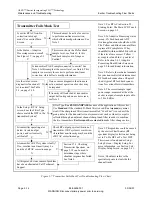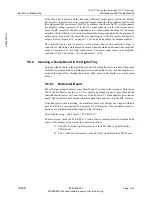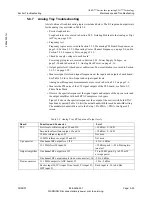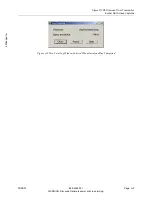
APEX
™
Exciter Incorporating FLO
™
Technology
Maintenance and Troubleshooting
System Troubleshooting
Page: 5-18
888-2604-001
03/08/07
WARNING: Disconnect primary power prior to servicing.
5.7.3
Checking Transmitter Spectrum
The spectrum analyzer display on the main screen of the exciter can be used to view the
spectral response at the outputs of the various stages within the transmitter PA system and
within the exciter. The process is as follows.
Note
Shoulders refers to the spectral response just outside the channel
limits.
1
On the main screen, in the RTAC section (lower left side), set the Lin HPF and Non
Lin functions to Bypass to disable RTAC correction.
2
In the Setup > Display screen, the Chart Source selections can be used to cause the
main screen spectrum analyzer to monitor the indicated locations in the exciter and PA
system. The Chart Source choices and their sources are listed below.
• Tx-Pre HPF: From rear panel RF sample input, labeled PA Sample.
• Tx-Post HPF: From rear panel RF sample input, labeled HPF Sample.
• FLO Ref: The FLO I and Q signal from the FPGA board.
• C: The FLO real signal from the FPGA board.
• D: The sample of the linear precorrector output.
• J: The sample of the non linear precorrector output.
• FLO w/RTAC: Digital signal taken at output of adaptive precorrector board.
• BIT: Sample of the Built In Test FIFO (for future use).
• Exciter: RF signal is taken from J4 sample output of exciter PA and connected to
J4 sample input on down converter board.
3
With the RTAC correction bypassed and the transmitter operating at 100% power, the
shoulder response should be as follows:
A
After the transmitter PA, they should be in the range of 30 to 32 dB below the
response at the center of the channel.
B
At the output of the exciter, and any point within the exciter, the shoulders
should be 38 dB below the response at the center of the channel.
If the shoulder response at and before the output of the exciter is not at least 38 dB be-
low the response at the center of the channel, and the shoulder response is not at least
50 dB below the response at the center of the channel, the exciter is not operating
properly.
4
When RTAC is operating, it is precorrecting for the transmitter IPA and PA non-lin-
earities, therefore, the shoulder response at the output of the PA should be 38 dB or
more below the response at the center of the channel. Before the PA, the shoulders will
not look as good due to precorrection of the signal.
5.7.4
ASI Transport Stream Faults
The input signal to the exciter is the ASI transport signal. Faults on the Status > ASI Input
> Transport Stream Status screen could be caused by a faulty input transport stream.





























